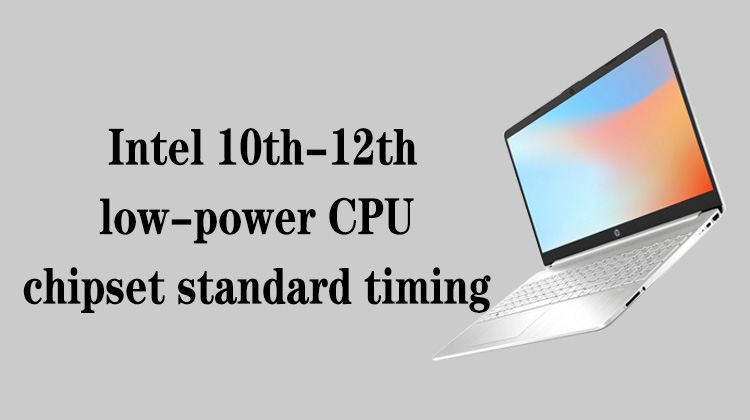1
00:00:00,333 --> 00:00:03,166
Hello everyone, today we will learn about the boot sequence
2
00:00:03,166 --> 00:00:08,200
in the standard timing of Intel's 10th to 12th generation low-power CPU chipsets
3
00:00:11,633 --> 00:00:17,866
This lesson includes the signal explanation of the boot sequence and the introduction of the boot process
4
00:00:19,900 --> 00:00:23,833
First, let's look at the signal explanation of the boot sequence
5
00:00:25,033 --> 00:00:31,800
The first signal, PWRBTN#, which is the falling edge trigger signal received by the CPU
6
00:00:34,233 --> 00:00:38,966
It is high in standby mode, it will be pulled low after pressing the switch,
7
00:00:39,500 --> 00:00:42,500
and it will return to high after releasing the switch
8
00:00:46,900 --> 00:00:49,166
The second one, SLP_A#,
9
00:00:49,500 --> 00:00:53,133
this signal was used to turn on the power supply of the ME module
10
00:00:54,833 --> 00:00:58,900
But now there is no ME power supply, so this signal is not used
11
00:01:03,900 --> 00:01:06,266
The third one, CL_RST#,
12
00:01:07,700 --> 00:01:12,433
it is used to reset the wireless network card when supporting the Intel AMT function
13
00:01:16,466 --> 00:01:20,933
PLATFORM VCCASW, this is the ME module power supply,
14
00:01:22,800 --> 00:01:26,366
the module has been canceled, it can not be found in the circuit diagram
15
00:01:28,400 --> 00:01:37,066
Next, SLP_LAN# and SLP_WLAN# are the power supply start signals of wired network card and wireless network card
16
00:01:41,866 --> 00:01:45,400
VCC_LANPHY is the power supply of the network card,
17
00:01:46,266 --> 00:01:50,600
VCC_WLANPHY is the power supply of the wireless network card
18
00:01:52,766 --> 00:01:58,066
SLP_S5# means that the CPU exits the shutdown state after receiving the switch signal
19
00:02:08,033 --> 00:02:11,466
SLP_S4# is usually used to turn on memory power supply
20
00:02:15,766 --> 00:02:20,666
SLP_S3# is usually used to turn on the power supply required for the S0 state
21
00:02:24,700 --> 00:02:26,366
SLP_S0#
22
00:02:26,866 --> 00:02:33,766
When the CPU is in the idle state, this signal will control the CPU power supply to enter the low power mode
23
00:02:34,800 --> 00:02:39,166
This signal can also be connected to the EC for other power management
24
00:02:43,933 --> 00:02:46,600
The last one, CPU_C10_GATE#,
25
00:02:47,466 --> 00:02:53,800
this signal is usually used to control the opening and closing of VCCST and VCCSTG power supply
26
00:02:57,800 --> 00:03:01,433
When the CPU enters the C10 state, which is the idle state,
27
00:03:01,900 --> 00:03:05,933
this signal will turn off VCCST and VCCSTG
28
00:03:12,233 --> 00:03:18,466
In normal operation, this signal is high, it will turn on VCCST and VCCSTG
29
00:03:22,300 --> 00:03:24,333
Now, let's take a look at the boot process
30
00:03:31,300 --> 00:03:35,200
First, the CPU must meet the 11 major standby conditions
31
00:03:35,933 --> 00:03:42,300
After the standby conditions are normal, the CPU needs to read the ME program in the BIOS and configure the pins
32
00:03:46,200 --> 00:03:49,266
Then, the EC standby condition must be satisfied
33
00:03:50,033 --> 00:03:57,566
Including EC standby power supply, EC standby clock, EC standby reset and EC standby program, etc.
34
00:03:59,366 --> 00:04:02,233
And the switch pin and LID signal should be high level
35
00:04:05,400 --> 00:04:06,766
Then, press the switch
36
00:04:09,366 --> 00:04:11,500
After the EC receives the switch signal,
37
00:04:11,800 --> 00:04:17,166
it delays and sends a "high --> low --> high" switch signal to the PWRBTN# pin of the CPU
38
00:04:19,000 --> 00:04:24,600
The CPU will set SLP_S5#, SLP_S4#, SLP_S3# to high
39
00:04:24,600 --> 00:04:27,833
in order to turn on the power supplies of the following channels
40
00:04:29,266 --> 00:04:35,300
At the same time, CPU_C10_GATE# will be issued to control the opening of VCCST power supply
41
00:04:38,566 --> 00:04:40,533
Ok, this is the boot process







